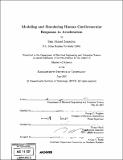Modeling and simulating human cardiovascular response to acceleration
Author(s)
Zamanian, Sam Ahmad
DownloadFull printable version (6.571Mb)
Other Contributors
Massachusetts Institute of Technology. Dept. of Electrical Engineering and Computer Science.
Advisor
George C. Verghese and Thomas Heldt.
Terms of use
Metadata
Show full item recordAbstract
The human cardiovascular system routinely encounters conditions that cause it to adapt. For example, when an astronaut enters microgravity, his/her cardiovascular system adapts rapidly to the weightless environment with no functional impairment. This adaptation is entirely appropriate while in space. However, it predisposes astronauts to problems when they return. It has been suggested that the regimen for astronauts on long-duration space travel include periods of artificial acceleration via centrifugation, in order to maintain some exposure to a gravitational gradient and thus ameliorate some of the physiological consequences of exposure to microgravity. To design such an intervention, it is desirable to know and understand, as well as to predict the cardiovascular response to centrifugation stress. A reasonably compartmentalized mathematical model of the cardiovascular system that represents these conditions is presented, which will allow for understanding and predicting cardiovascular behavior under such conditions. We validated our simulations against human data and showed that our results closely matched the experimental data. Upon validation, we used our model to predict the response of the cardiovascular system to levels of stress that cannot yet be tested on human subjects.
Description
Thesis (S.M.)--Massachusetts Institute of Technology, Dept. of Electrical Engineering and Computer Science, 2007. Includes bibliographical references (p. 95-98).
Date issued
2007Department
Massachusetts Institute of Technology. Department of Electrical Engineering and Computer SciencePublisher
Massachusetts Institute of Technology
Keywords
Electrical Engineering and Computer Science.